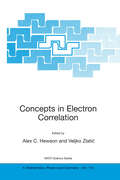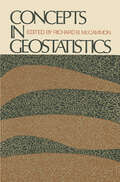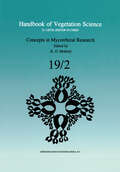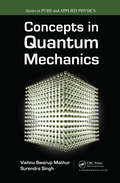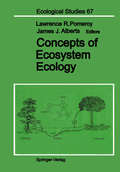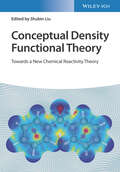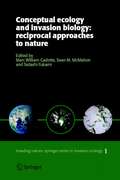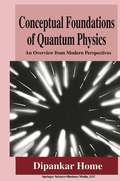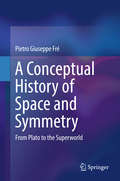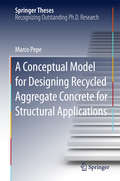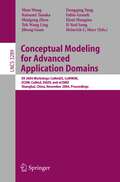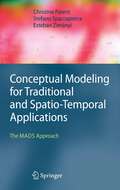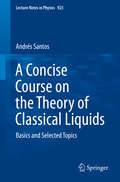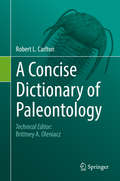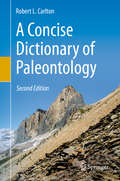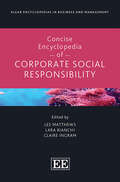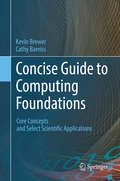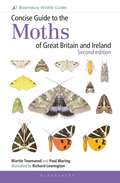- Table View
- List View
Concepts in Electron Correlation (NATO Science Series II: Mathematics, Physics and Chemistry #110)
by Alex C. Hewson Veljko ZlaticThe NATO sponsored Advanced Research Workshop on "Concepts in Electron Correlation" took place on the Croatian island of Hvar during the period from the 29th of September to the 3rd of October, 2002. The topic of electron correlation is a fundamental one in the field of condensed matter, and one that is being very actively studied both experimentally and theoretically at the present time. The manifestations of electron cor relation are diverse, and play an important role in systems ranging from high temperature superconductors, heavy fermions, manganite compounds with colossal magnetoresistance, transition metal compounds with metal insulator transitions, to mesoscopic systems and quantum dots. The aim of the workshop was to provide an opportunity for a dialogue between exper imentalists and theoreticians to assess the current state of understanding, and to set an agenda for future work. There was also a follow-up workshop on the same topic where the presentations included more background and introductory material for younger researchers in the field. The papers presented in these proceedings clearly demonstrate the di versity of current research on electron correlation. They show that real progress is being made in characterising systems experimentally and in developing theoretical approaches for a quantitative comparison with ex periment. The more one learns, however, the more there is to understand, and many of the contributions help to map out the territory which has yet to be explored. We hope that the articles in this volume will be a stimulus for such future work.
Concepts in Geostatistics (Springer Study Edition)
by Richard B. McCammonA two-week summer short course entitled Current Statistical Methods in Geology supported by the National Science Foundation was held at the University of Illinois at Chicago Circle in Chicago, Illinois from June 19 to June 30, 1972. The aim of the short course was to bridge the gap between the traditional first courses in sta tistics offered at most educational institutions and geostatistics as it is being developed by geologists and statisticians engaged in the application of statistics in geology. The course was intended for geology college teachers who were either then teaching or preparing to teach a course within their department dealing with computer ap plications and the use of statistical methods in geology. This book arose out of the class notes which were prepared by the course director and the invited lecturers. We are grateful to the 28 teachers who attended for their enthu siastic interest and thoughtful responses to the many statistical concepts presented to them as geologists during the two weeks of the course. I am deeply grateful to my graduate assistants, Richard Kolb and Andrea Krivz, for the long hours spent in collating the course mater ials, testing the various computer programs, and instructing the par ticipants in the use of computer BASIC.
Concepts in Mycorrhizal Research (Handbook of Vegetation Science #19/2)
by K. G. MukerjiMycorrhiza will be the focus of research and study for the coming decade. Successful survival and maintenance of plant cover is mostly dependent on mycorrhization. During the last decade about ten books have appeared on various aspects of mycorrhiza, including two on methodology. The present book has been compiled to give a complete and comprehensive description of the topic to the students and researchers in botany, applied mycology, biotechnology, forestry and agriculture. The book will also be useful to planners dealing with biofertilizers and forestation. Besides topics of academic interest, the volume includes several aspects which are unique and are written about for the first time, e.g.: Arbuscular Mycorrhizal symbiosis - recognition and specificity; Mycorrhizal Integration and cellular compatibility between Endomycorrhizal symbionts; Cost - economics of existing methodology for inoculum production of vesicular-arbuscular mycorrhizal fungi; Mycorrhiza: Ecological Implications of Plant interactions; Outplanting performance of mycorrhizal inoculated seedlings; Fluorescence microscopy in mycorrhiza studies and Ectomycorrhizal fungi as experimental organism. Other aspects not mentioned above include most recent reviews concerning vesicular-arbuscular mycorrhiza and ectomycorrhizae. The different review chapters have been written by world authorities in their respective specialisations giving more up to date information than is provided anywhere else. This book deals with all major aspects of mycorrhiza, giving structure, ultrastructure, ecology and applications in agriculture and forestry.
Concepts in Quantum Mechanics (Pure And Applied Physics Ser.)
by Vishnu S. MathurTaking a conceptual approach to the subject, Concepts in Quantum Mechanics provides complete coverage of both basic and advanced topics. Following in the footsteps of Dirac's classic work Principles of Quantum Mechanics, it explains all themes from first principles.The authors present alternative ways of representing the state of a physical system,
Concepts of Ecosystem Ecology: A Comparative View (Ecological Studies #67)
by J. J. Alberts R. T. Barber D. C. Coleman K. W. Cummins C. F. D'Elia J. K. Detling E. C. Hargrove P. F. Hendrix K. H. Mann S. L. Pimm L. R. Pomeroy W. A. Reiners P. H. Rich P. G. Risser J. E. Schindler H. H. Shugart D. L. Urban W. J. Wiebe R. G. WiegertIn this volume 19 leading experts offer a timely and coherent overview of the fundamental principles of ecosystem science. They examine the flux of energy and biologically essential elements and their associated food webs in major terrestrial and aquatic ecosystems, such as forests, grasslands, cultivated land, streams, coral reefs, and ocean basins. In each case, interactions between different eosystems, predictive models, and the application of ecosystem research to the management of natural resources are given special emphasis. A number of theoretical chapters provide a synthesis through critical discussion of current concepts of ecosystem energetics and dynamics.
Conceptual Density Functional Theory: Towards a New Chemical Reactivity Theory
by Shubin LiuConceptual Density Functional Theory A unique resource that combines experimental and theoretical qualitative computing methods for a new foundation of chemical reactivity This two-volume reference book shows how conceptual density functional theory can reconcile empirical observations within silico calculations using density functional theory, molecular orbital theory, and valence bond theory. The ability to predict properties like electronegativity, acidity/basicity, strong covalent and weak intermolecular interactions as well as chemical reactivity makes DFT directly applicable to almost all problems in applied chemistry, from synthetic chemistry to catalyst design and materials characterization. Edited by one of the most recognized experts in the field and contributed to by a panel of international experts, the work addresses topics such as: Qualitative methods that are capable of rationalizing chemical concepts derived from theory and computation Fundamental concepts like the computation of chemical bonding, weak interactions, and reactivity Computational approaches for chemical concepts in excited states, extended systems, and time-dependent processes Theoretical chemists and physicists, as well as those applying theoretical calculations to empirical problems, will be able to use this book to gain unique insight into how theory intersects with experimental data in the field of qualitative computation.
Conceptual Density Functional Theory: Towards a New Chemical Reactivity Theory
by Shubin LiuConceptual Density Functional Theory A unique resource that combines experimental and theoretical qualitative computing methods for a new foundation of chemical reactivity This two-volume reference book shows how conceptual density functional theory can reconcile empirical observations within silico calculations using density functional theory, molecular orbital theory, and valence bond theory. The ability to predict properties like electronegativity, acidity/basicity, strong covalent and weak intermolecular interactions as well as chemical reactivity makes DFT directly applicable to almost all problems in applied chemistry, from synthetic chemistry to catalyst design and materials characterization. Edited by one of the most recognized experts in the field and contributed to by a panel of international experts, the work addresses topics such as: Qualitative methods that are capable of rationalizing chemical concepts derived from theory and computation Fundamental concepts like the computation of chemical bonding, weak interactions, and reactivity Computational approaches for chemical concepts in excited states, extended systems, and time-dependent processes Theoretical chemists and physicists, as well as those applying theoretical calculations to empirical problems, will be able to use this book to gain unique insight into how theory intersects with experimental data in the field of qualitative computation.
Conceptual Ecology and Invasion Biology: Reciprocal Approaches to Nature (Invading Nature - Springer Series in Invasion Ecology #1)
by Marc W. Cadotte Sean M. McMahon Tadashi FukamiIn this edited volume, global experts in ecology and evolutionary biology explore how theories in ecology elucidate the processes of invasion, while also examining how specific invasions inform ecological theory. This reciprocal benefit is highlighted in a number of scales of organization: population, community and biogeographic. The text describes example invaders in all major groups of organisms and from a number of regions around the globe.
Conceptual Foundations of Quantum Physics: An Overview from Modern Perspectives
by Dipankar HomeIt may tum out that, like certain other phenomena studied by sociologists, bouts of interest in the foundations of quantum mechanics tend to come in 60-year cycles. It is hardly surprising that in the first decade or so of the subject the conceptual puzzles generated by this strange new way of looking at the world should have generated profound interest, not just among professional physicists themselves but also among philosophers and informed laymen; but this intense interest was followed by a fallow period in the forties and fifties when the physics establishment by and large took the view that the only puzzles left were the product either of incompetent application of the formalism or of bad philosophy, and only a few brave individualists like the late David Bohm dared to suggest that maybe there really was something there after all to worry about. As Bell and Nauenberg, surveying the scene in 1966, put it: "The typical physicist feels that [these questions 1 have long ago been answered, and that he will fully understand how if ever he can spare twenty minutes to think about it. " But gradually, through the sixties and seventies, curiosity did revive, and the last ten years or so have seen a level of interest in foundational questions, and an involvement in them by some of the leading figures of contemporary physics, which is probably unparalleled since the earliest days.
A Conceptual History of Space and Symmetry
by Pietro Giuseppe FréThis book presents the author’s personal historical perspective and conceptual analysis on symmetry and geometry. The author enlightens with modern views the historical process which led to the contemporary vision of space and symmetry that are used in theoretical physics and in particular in such abstract and advanced descriptions of the physical world as those provided by supergravity. The book is written intertwining storytelling and philosophical argumentation with some essential technical material. The author argues that symmetry and geometry are inextricably entangled and their current meaning is the result of a long process of abstraction which was determined through history and can be understood within the analytic system of thought of western civilization that started with the Ancient Greeks. The evolution of geometry and symmetry theory in the last forty years has been deeply and constructively influenced by supersymmetry/supergravity and the allied constructions of strings and branes. Further advances in theoretical physics cannot be based simply on the Galilean method of interrogating nature and then formulating a testable theory to explain the observed phenomena. One ought to interrogate human thought, meaning frontier-line mathematics concerned with geometry and symmetry in order to find there the threads of so far unobserved correspondences, reinterpretations and renewed conceptions.
A Conceptual Model for Designing Recycled Aggregate Concrete for Structural Applications (Springer Theses)
by Marco PepeThis book reports on the physical and mechanical characterization of Recycled Aggregate Concrete (RAC), produced through a partial-to-total replacement of ordinary aggregates with what have been dubbed Recycled Concrete Aggregates (RCAs). It proposes a theoretical framework for understanding the relationships between RCAs and RCA, and for predicting the resulting behavior of RAC. The book demonstrates that in the case of RAC two additional parameters have to be taken into account than with ordinary aggregates, due to the composite nature and higher porosity of RCAs. By extending Abrams’ Law for Recycled Aggregate Concrete, it represents a first step in the formulation of a general model for predicting the properties of RAC. The theoretical approach presented here addresses an important gap in the literature and is expected to stimulate new research on the use of this more sustainable form of concrete in structural applications.
Conceptual Modeling for Advanced Application Domains: ER 2004 Workshops CoMoGIS, CoMWIM, ECDM, CoMoA, DGOV, and eCOMO, Shanghai, China, November 8-12, 2004. Proceedings (Lecture Notes in Computer Science #3289)
by Shan Wang Katsumi Tanaka Shuigeng Zhou Tok Wang Ling Jihong Guan Dongqing Yang Fabio Grandi Eleni Mangina Il-Yeol Song Heinrich C. MayrConceptual Modeling for Traditional and Spatio-Temporal Applications: The MADS Approach
by Christine Parent Stefano Spaccapietra Esteban ZimányiFrom environmental management to land planning and geo-marketing, the number of application domains that may greatly benefit from using data enriched with spatio-temporal features is expanding very rapidly. This book shows that a conceptual design approach for spatio-temporal databases is both feasible and easy to apprehend. While providing a firm basis through extensive discussion of traditional data modeling concepts, the major focus of the book is on modeling spatial and temporal information.
A Concise Course on the Theory of Classical Liquids: Basics and Selected Topics (Lecture Notes in Physics #923)
by Andrés SantosThis short primer offers non-specialist readers a concise, yet comprehensive introduction to the field of classical fluids – providing both fundamental information and a number of selected topics to bridge the gap between the basics and ongoing research. In particular, hard-sphere systems represent a favorite playground in statistical mechanics, both in and out of equilibrium, as they represent the simplest models of many-body systems of interacting particles, and at higher temperature and densities they have proven to be very useful as reference systems for real fluids. Moreover, their usefulness in the realm of soft condensed matter has become increasingly recognized – for instance, the effective interaction among (sterically stabilized) colloidal particles can be tuned to almost perfectly match the hard-sphere model. These lecture notes present a brief, self-contained overview of equilibrium statistical mechanics of classical fluids, with special applications to both the structural and thermodynamic properties of systems made of particles interacting via the hard-sphere potential or closely related model potentials. In particular it addresses the exact statistical-mechanical properties of one-dimensional systems, the issue of thermodynamic (in)consistency among different routes in the context of several approximate theories, and the construction of analytical or semi-analytical approximations for the structural properties.Written pedagogically at the graduate level, with many figures, tables, photographs, and guided end-of-chapter exercises, this introductory text benefits students and newcomers to the field alike.
A Concise Dictionary of Paleontology
by Robert L. CarltonThis authored dictionary presents a unique glossary of paleontological terms, taxa, localities, and concepts, with focus on the most significant orders, genera, and species in terms of historical turning points such as mass extinctions. The book is an accurate and up-to-date collection of the most important paleontological terms and taxa, and may be used as a resource by students, researchers, libraries, and museums.Though useful to many in professional and academic settings, the book is also aimed at general readers of scientific literature who may enjoy the material without a background in paleontology. While there are many current resources on the subject, few fully encapsulate an accurate representation of the paleontological lexicon. This book attempts to compile such a representation in a moderately comprehensive manner, and includes a list of the most important monographs and articles that have been consulted to put together this essential work.
A Concise Dictionary of Paleontology: Second Edition
by Robert L. CarltonThis new and significantly updated authored dictionary is a unique glossary of paleontological terms, taxa, localities, and concepts. It focuses primarily on identifying the most significant groups of fossil animals and plants in relation to their evolution and phylogeny. It also focuses on mass extinctions, on taxa that are problematic in some significant way, on the principal fossil-Lagerstätten of the world, and on historical turning points marked by index fossils. Although there are many current resources on the subject, none contains an accurate representation of the paleontological lexicon. Although well aware that the fast-changing field of paleontology will always defy any attempt at complete description, the author has attempted to provide an accurate and comprehensive set of about 4,000 entries that will be useful to professionals as well as to general readers of scientific literature without a background in paleontology.
Concise Encyclopedia of Corporate Social Responsibility (Elgar Encyclopedias in Business and Management series)
This Concise Encyclopedia is an interdisciplinary overview of the field of Corporate Social Responsibility (CSR). It not only incorporates well-established concepts proffered by highly influential voices, but also captures the perspectives of tomorrow.The entries present some of the main topics gravitating around CSR and its theoretical evolution, while recognising how the framework has spread out into different academic fields. This Concise Encyclopedia helps to update CSR scholarship in line with developments within the broader discourse on the responsibilities of business, with new reflections on well-established concepts.Presenting a state-of-the-art discussion on the evolution of and future for CSR, this Concise Encyclopedia will serve as a significant reference point for both scholars and students of Business Ethics, Business and Human Rights and Corporate Sustainability. The depth of discussion throughout the Concise Encyclopedia will be useful for academics, practitioners, and policymakers alike.Key Features:46 accessible and fully-referenced entriesContributions from leading scholars and academics in the fieldWritten in a critical and reflective style, with entries grounded in ongoing debates on CSRRecognition of Business and Human Rights (BHR) as an emergent theme within CSR, with entries on modern slavery and workers’ rights
Concise Guide to Computing Foundations: Core Concepts and Select Scientific Applications
by Kevin Brewer Cathy BareissThis book will help future scientists to become more intelligent users of computing technology in their practice of science. The content is suitable for introductory courses on the foundations of computing and the specific application of computers in different areas of science. The text presents a set of modules for use in existing science courses in order to integrate individual aspects of computational thinking, as well as a set of modules introducing the computer science concepts needed to understand the computing involved. These modules guide science students in their independent learning. The book covers computing applications in such diverse areas as bioinformatics, chemical kinetics, hydrogeological modeling, and mechanics of materials, geographic information systems, flow analysis, the solving of equations, curve fitting, optimization, and scientific data acquisition. The computing topics covered include simulations, errors, data representation, algorithms, XMS, compression, databases, performance, and complexity.
Concise Guide to the Moths of Great Britain and Ireland: Second edition
by Martin Townsend Paul Waring'A remarkable field guide ... one of those books that come along every now and then and cause a revolution.'Michael McCarthyIndependentThis concise guide is a companion to the main Field Guide to the Moths of Great Britain and Ireland by the same expert authors, but is in a condensed form with artwork opposite the species descriptions and lay-flat binding for ease of use in the field. It includes brief but comprehensive field descriptions of all the macro-moths in Great Britain, Ireland, the Isle of Man and the Channel Islands, and this second edition has been thoroughly revised and updated to reflect the latest advances in taxonomy. Featuring more than 1,700 superbly detailed colour artworks and covering nearly 900 species, this portable guide is an essential addition to every moth-lover's field kit.
A Concise History of China’s Population (China Perspectives)
by Jianxiong GeThis book provides a comprehensive overview and explanation of China’s population, analyzing its special characteristics and patterns of growth over the past 2,000 years. Topics include its composition, distribution, migration, and deep analysis into China’s historical population. The author aims to answer complicated questions such as how China’s population was formed, when China started its earliest population surveys, how China’s population migrated and was distributed historically, and how existing population data should be evaluated and used now? In addition, the author explores the influence of natural and human-caused disasters, censuses, tax policies, and economic development on China’s population changes. The work also offers a span of rich historical detail related to population control. The book will be a great read to students and scholars of population studies, Chinese studies, ethnology, and those who are interested in Chinese history, archaeology, geography, and sociology.
A Concise History of China’s Population (China Perspectives)
by Jianxiong GeThis book provides a comprehensive overview and explanation of China’s population, analyzing its special characteristics and patterns of growth over the past 2,000 years. Topics include its composition, distribution, migration, and deep analysis into China’s historical population. The author aims to answer complicated questions such as how China’s population was formed, when China started its earliest population surveys, how China’s population migrated and was distributed historically, and how existing population data should be evaluated and used now? In addition, the author explores the influence of natural and human-caused disasters, censuses, tax policies, and economic development on China’s population changes. The work also offers a span of rich historical detail related to population control. The book will be a great read to students and scholars of population studies, Chinese studies, ethnology, and those who are interested in Chinese history, archaeology, geography, and sociology.
A Concise History of Mining
by Cedric.E. GregoryA history of mining. This revised edition in a way describes the history of civilization and the early development of nations. Where minerals and mining existed, they provided ingredients for weapons, wealth and world power. The text should be useful in today's period of developing countries.
A Concise History of Mining
by Cedric.E. GregoryA history of mining. This revised edition in a way describes the history of civilization and the early development of nations. Where minerals and mining existed, they provided ingredients for weapons, wealth and world power. The text should be useful in today's period of developing countries.
A Concise Introduction to Linear Algebra
by Géza SchayBuilding on the author's previous edition on the subject (Introduction to Linear Algebra, Jones & Bartlett, 1996), this book offers a refreshingly concise text suitable for a standard course in linear algebra, presenting a carefully selected array of essential topics that can be thoroughly covered in a single semester. Although the exposition generally falls in line with the material recommended by the Linear Algebra Curriculum Study Group, it notably deviates in providing an early emphasis on the geometric foundations of linear algebra. This gives students a more intuitive understanding of the subject and enables an easier grasp of more abstract concepts covered later in the course. The focus throughout is rooted in the mathematical fundamentals, but the text also investigates a number of interesting applications, including a section on computer graphics, a chapter on numerical methods, and many exercises and examples using MATLAB. Meanwhile, many visuals and problems (a complete solutions manual is available to instructors) are included to enhance and reinforce understanding throughout the book. Brief yet precise and rigorous, this work is an ideal choice for a one-semester course in linear algebra targeted primarily at math or physics majors. It is a valuable tool for any professor who teaches the subject.
Concise Introduction to Sustainable Consumption (Elgar Concise Introductions)
by John ThøgersenOur Elgar Concise Introductions are inspiring and considered introductions to the key principles in business, expertly written by some of the world’s leading scholars. The aims of the series are two-fold: to pinpoint essential principles of business and management, and to offer insights that stimulate critical thinking.Examining the psychological and social drivers of unsustainable and sustainable consumption, this Concise Introduction provides an insightful overview of the causes of unsustainable consumer behaviour and the instruments and interventions needed to create a sustainable consumption pattern. Key Features:Outlines how policy interventions can contribute to a transformation in the consumption patternBased on a comprehensive model of the causes and consequences of (un)sustainable consumer choicesProvides a precise account of how the structure and distribution of consumption are responsible for environmental problemsMaps the roots of unsustainable consumption in human nature as well as in economic, institutional, social, and structural contextsHighlighting a variety of ways to promote sustainable consumption, from sustainability labelling to carbon taxes and infrastructure investments, this Concise Introduction will be essential reading for students and researchers in behavioural sciences, business and management, economic psychology, environmental sociology, and sustainable development.
